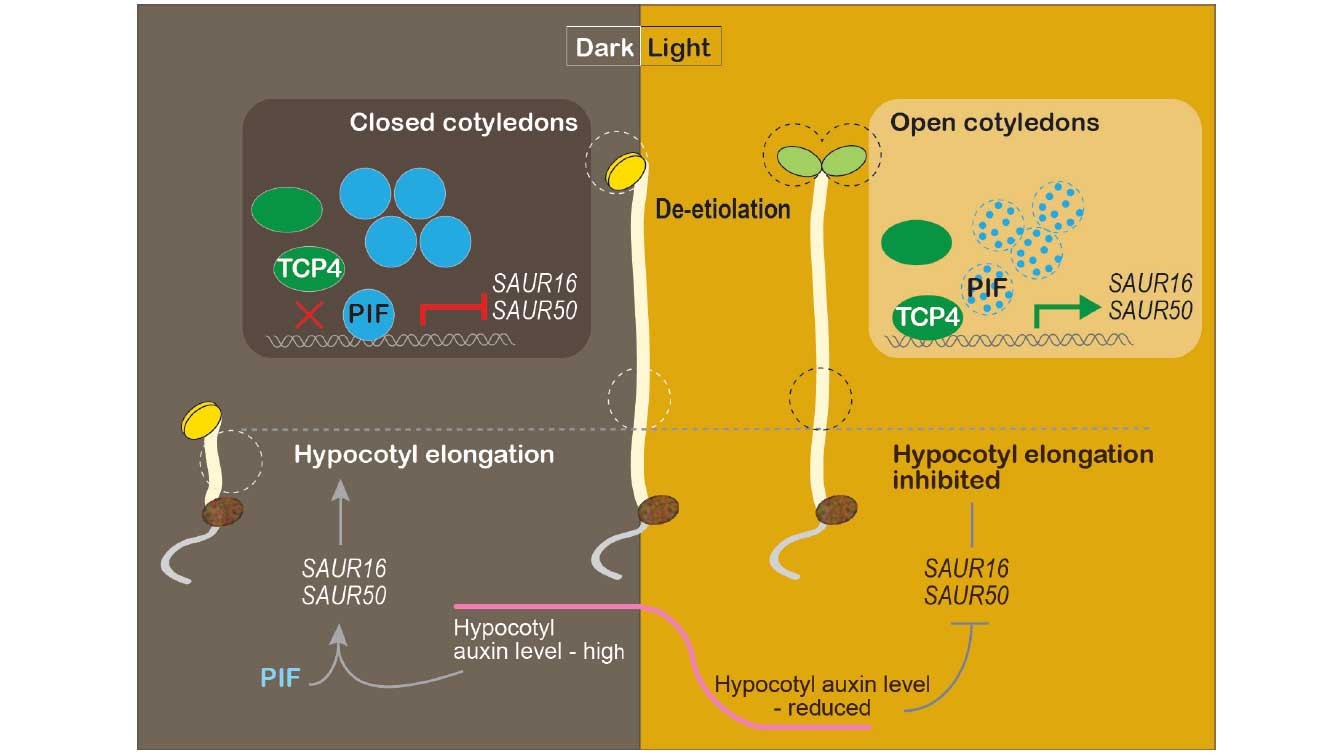博文
Plant Cell:TCP4和PIF3拮抗调控拟南芥幼苗去黄化过程中的子叶展开
||
TCP4 and PIF3 antagonistically regulate organ-specific light induction of SAUR16/50 to modulate cotyledon opening during de-etiolation in Arabidopsis
First author: Jie Dong; Affiliations: Yale University (耶鲁大学): New Haven, USA
Corresponding author: Ning Wei
Light elicits different growth responses in different organs, and those organ-specific responses are prominently displayed during de-etiolation. While major light responsive components and early signaling pathways in this process have been identified, this information has yet to explain how organ-specific light responses are achieved. Here we report that the developmental regulator TCP (TEOSINTE BRANCHED1, CYCLOIDEA, and PCF) family of transcription factors participate in photomorphogenesis and facilitate light-induced cotyledon-opening. ChIP-seq and RNA-seq analyses indicate that TCP4 targets a number of SAUR (Small Auxin Up RNA) genes, which have previously been shown to exhibit organ-specific light responsive expression. We demonstrate that TCP4-like transcription factors, which are predominantly expressed in the cotyledons of both light and dark grown seedlings, activate SAUR16 and SAUR50 in response to light. Light regulates the binding of TCP4 to the promoters of SAUR14/16/50 through PIFs (PHYTOCHROME-INTERACTING FACTORs). We show that PIF3, which accumulates in etiolated seedlings and whose levels rapidly decline upon light exposure, also binds to the SAUR16/50 promoter while suppressing TCP4 promoter-binding in darkness. Our study reveals that the interplay between light responsive factors PIFs and the developmental regulator TCP4 determines the cotyledon-specific light regulation of SAUR16/50, which contributes to cotyledon closure and opening before and after de-etiolation.
光能诱导植物不同器官的不同生长响应,并且这些器官特异性响应主要在植物的去黄化过程中表现。该过程中主要的光响应组份以及早期信号转导通路都已经被鉴定出来,但目前对于植物是如何获取器官特异性响应的还不清楚。本文,作者报道了发育调控子TCP转录因子家族参与了植物的光形态发生,促进了光诱导的子叶展开。ChIP-seq和RNA-seq分析显示TCP4能够靶向一系列的SAUR基因,而这些SAUR基因在先前的研究中被证明存在器官特异性的光响应表达。本文的研究显示无论是在光照或是黑暗条件下培养的幼苗中,均主要在子叶中表达的类TCP4转录因子在响应光照条件下能够激活SAUR16和SAUR50的表达。光调控TCP4通过PIF结合到SAUR14/16/50的启动子区。作者还显示PIF3在黄化的幼苗中积累,然后在光照条件下的含量迅速下降,在黑暗条件下,该蛋白能够结合到SAUR16/50的启动子区,并抑制TCP4结合到启动子区。本文的研究揭示了光响应因子PIF和发育调控子TCP4一起决定了SAUR16/50的子叶特异性光调控,从而作用于子叶在去黄化前的闭合和去黄化后的展开。
通讯:Ning Wei (https://mcdb.yale.edu/people/ning-wei)
个人简介:北京大学,学士;加州大学伯克利分校,博士。
研究方向:CSN复合物在植物生长和发育中的作用。
doi: https://doi.org/10.1105/tpc.18.00803
Journal: Plant Cell
First Published: March 25, 2019
https://blog.sciencenet.cn/blog-3158122-1171263.html
上一篇:CURR OPIN PLANT BIOL:植物细胞表面免疫受体复合物研究综述
下一篇:Plant Physiology:拟南芥生长素极性运输亚细胞层面的分子调控机制
全部作者的其他最新博文
- • Plant Physiology:CsMADS3促进柑果中的叶绿素降解和类胡萝卜素合成(华中农业大学)
- • Molecular Plant:LBD11-ROS反馈调节作用于拟南芥的维管形成层增殖和次生生长(浦项科技大学)
- • Science Advances:根结线虫通过调控植物的CLE3-CLV1模块,促进侵染进程(日本熊本大学)
- • Nature Communications:油菜素内酯参与植物营养生长期转变的分子机制解析(浙江农林大学)
- • Current Biology:光合作用产生的蔗糖驱动侧根“生物钟”(德国弗莱堡大学)
- • PNAS:花同源异型基因在叶中被抑制、花中被激活的分子机制(南卡罗来纳大学)

